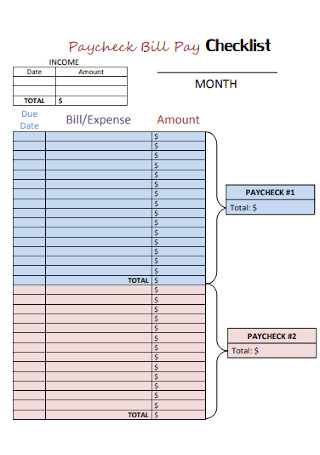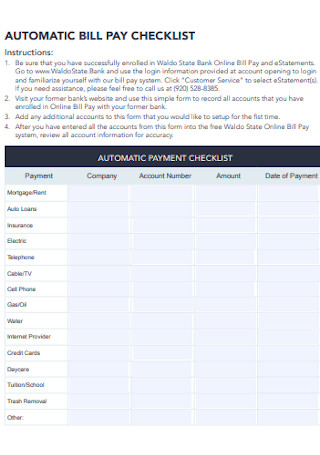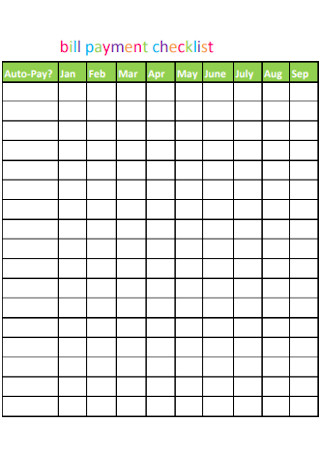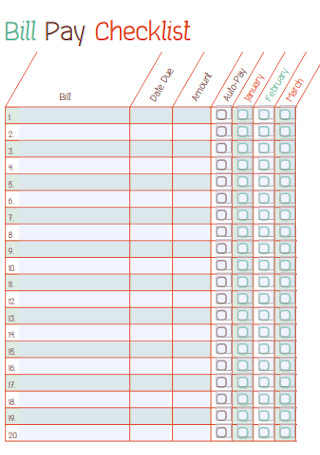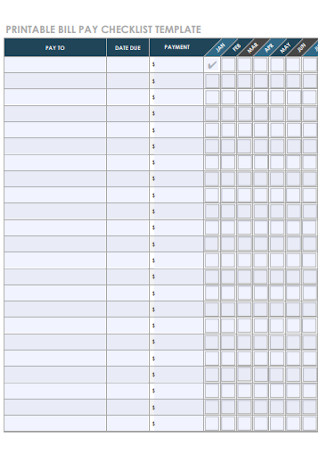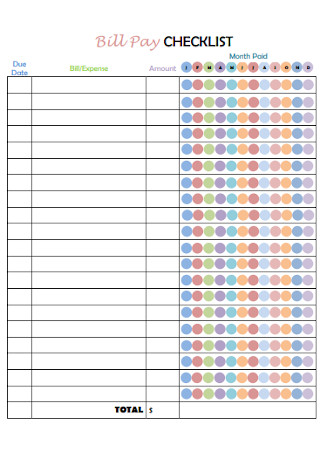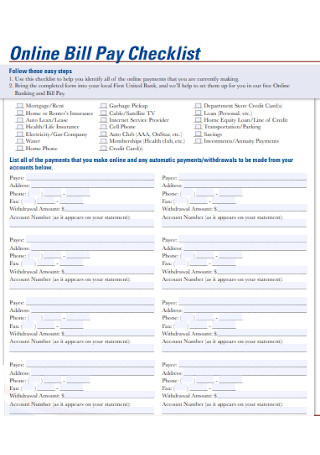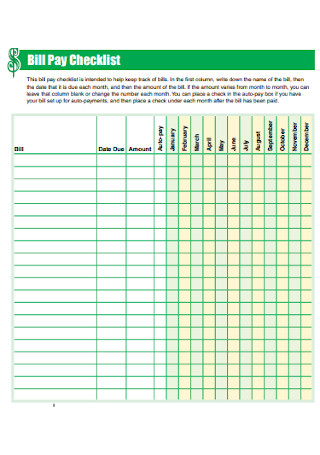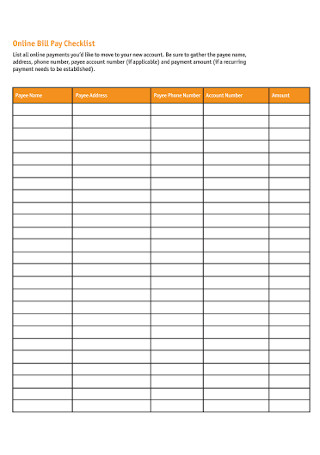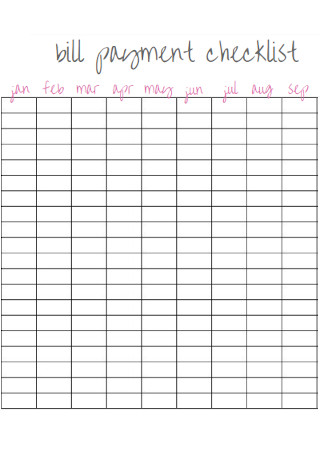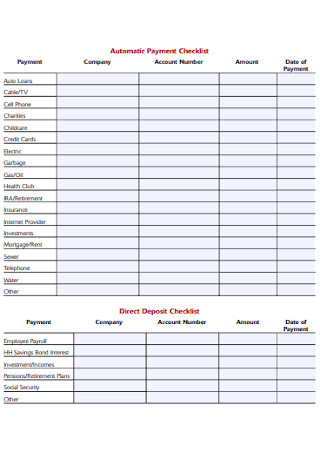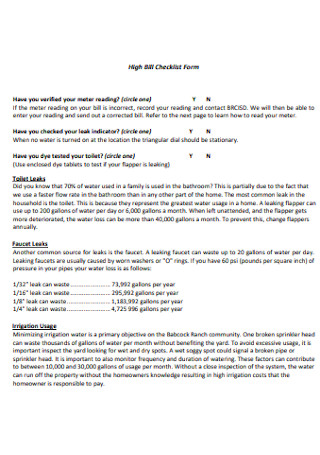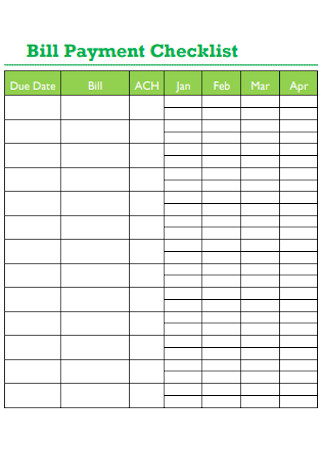15+ Sample Bill Pay Checklists
FREE Bill Pay Checklist s to Download
What Is a Bill Pay Checklist?
A bill pay checklist is a list of items to pay, usually on a recurring basis. Bills are statement accounts that are charged to a person, household, or company. Paying bills is a common practice for many adults.
According to Business Wire, utilities rank as the second most expensive bill overall in the United States. The nationwide average is $290 a month. The top spot went to auto loans as the most expensive common monthly bill.
Tips in Paying Your Bills
Are you one of those people that dread the first of the month or when a due date is looming? It’s a known reality that many people struggle to make ends meet. And bills are a constant and nagging reminder of that struggle. However, there are steps you can take to gradually take control of your bills. Instead of allowing the dreaded piece of paper to dictate your life, try these useful tips:
Don’t wait for the due date: Some people like to wait until the last minute to pay a bill. If you have difficulty paying on time for whatever reason, just make sure you don’t sit on it too long or allow much time to pass before settling the payment. It’s best to settle your accounts as soon as you can. You don’t want it lingering over your head and causing you unnecessary anxiety. Further, if you fail to pay your bills on time, you run the risk of incurring late fees or additional charges. Pay in full, if you are able: Sometimes, banks allow clients to pay a minimal amount or a fraction of their total bill. This is common practice, especially for credit card statements. Admittedly, it is not always easy for people to pay the full amount all the time. And surely, paying a little is better than not paying anything at all. But if you are capable of paying in full, it’s best to do so. Especially if you have multiple bills coming in, don’t wait until pending balances pile up and you end up scrambling to find a way to pay each one; or worse, lose track of your bills. Set up an autopay arrangement: Fortunately, there are available options you can take advantage of to help ease the bills paying process. Many banks allow clients to set an autopay arrangement. Whether it’s your semi-annual insurance policy or monthly electricity bill, you can opt to have it automatically deducted with your linked bank account. This is both practical and convenient. It’s one less thing to worry about when summarizing your expenses for the month. This way, you can make sure that your income covers your essential bills. Having to pay several bills at the same time can be a headache. But with an autopay arrangement, you can focus on other more important things. Avoid borrowing money to pay for bills: Of course, this is easier said than done. Many people already find it difficult to pay their monthly bills. Especially if a household is already struggling to make ends meet, debt can be the only option left. Unless absolutely necessary, don’t pay for a bill by taking out a loan or borrowing money from others. The added burden of having to repay a loan or debt can sometimes multiply the stress than actually paying the bill yourself. Find ways to cut down on expenses: This may sound like a buzzkill, but saving is a practical tip for keeping up with your bills. Without our realizing it, sometimes we end up paying at the end of the month for things that we barely even use. In order to save money, it’s best to cut off any unused utilities. These add unnecessary dues every month. You can save a lot more if you stop paying for things that no longer serve its purpose. For instance, with the onset of social media and in-demand entertainment, there are less and less people watching cable. If you do watch cable sparingly, decide if it’s worth paying each month. Are there magazine subscriptions that you no longer need? Note these miscellaneous fees and decide which ones are best to do without. Keep a bill tracking or monitoring tool: To avoid getting overwhelmed with the bills you have to pay each month, it’s best to organize and prioritize them. Your tracking tool doesn’t have to be sophisticated or complex, it just needs to serve as your reminder for on-time payment. With multiple bills coming in each time, prioritization is key. List down the bills that need urgent attention and indicate which ones are already paid. You can add remarks (e.g., pending, done) for every bill. To make it a little easier, use ready made templates so it saves time and energy. It’s as simple as editing it to your liking and filling in the necessary details.
Types of Bills
There are countless bills an individual will pay in his or her lifetime. Some bills can even outlive the payee himself. Of course that picture is an extreme; but unfortunately, some people do remain in debt until the day they die. It’s not a pleasant thought, but in our current economy and system, paying bills is not just the norm, but is a matter of survival. The following items are examples of common bills that people pay on a recurring basis:
Water: Water is an essential need for everyone. It’s unfortunate that in many parts of the world, there are still people who lack access to clean water. Those of us who are lucky enough to have running water 24/7, should not take it for granted. Like anything on this earth, even water is a finite resource. We should not wait for the time to come when water will no longer be as abundant or easily accessible. Saving water is an important reminder not just for bill-paying adults, but for everyone who uses it. Power: Like water, reliable electricity is a staple in a majority of households. And just like water, energy conservation is just as important. It’s easy to take electricity for granted because we have grown so accustomed to it that we forget that people in history didn’t use electricity the way we do now. For a lot of people, it’s hard to imagine a time where oil lamps and candles were the norm. Power bills vary from household to household. Obviously, the bigger the house, the greater the maintenance. The power bill of a bigger home is likely to be higher when compared to a smaller, lower maintenance home.Cellphone: If you are on a mobile data plan, it’s likely your phone bill makes it to your list of urgent or basic bills. Whatever network you subscribe to, you need to pay bills regularly to keep using the service. Data plans also come in different packages that marketers sell to clients and customers. It’s important to find a plan that suits your needs specifically. The last thing you want is to be paying regularly for unlimited calls when you rarely call and prefer to text people anyway. Subscriptions: The in-demand culture that has strengthened in recent years has seen a surge in countless streaming and info-sharing apps. These services require regular payments for you to continuously use them. A popular business model is the subscription model. Many companies especially in the entertainment and telecom industries subscribe to this model. Users sign up and pay recurring and fixed fees to avail of the service or product. Insurance: There are many types of insurance. Banks and other institutions offer all kinds of insurance such as life insurance, car insurance, health insurance, accident insurance, etc. To be insured, clients normally have to pay monthly or quarterly premiums. The amounts vary and can range anywhere from low to high. Typically, the bigger your insurance amount, the higher your monthly contribution. Loans: Individuals, families, and businesses take out loans for multiple reasons. A working class single mother may opt to take an auto loan because having a private car is more convenient for her and her kids. A newly wed couple could sign up for regular mortgage payments to provide a home for their growing family. The only thing you need to remember is a loan needs to be repaid. Lenders structure and restructure loan agreements all the time. But as the borrower, you need to be able to pay back the loan one way or another. Rent: For those people who choose to rent a home instead of purchasing one, rent dues are basic bills that need to be paid regularly. Whether it’s a rented townhouse, apartment, or condominium, you are leasing the area you’re living in. As a tenant, rent is your way of staying and maintaining a place to live in. In addition to basic rent, some developments or landlords require additional dues to help with the upkeep of services and common areas. These include association dues, common area maintenance fees, etc. Credit Card: For those people who use credit cards, a statement of account is regularly billed to the user. Despite its convenience and additional perks, owning a credit card requires a lot of responsibility. Make sure to religiously pay your monthly credit card bill. If you allow debt to consistently pile up, it will only cause further problems.
How to Create a Bill Pay Checklist
It’s fairly easy to create your own bill pay checklist. All you need is the right information and your preferred format. You can choose how simple or detailed you want your checklist to be. What matters is that you can rely on your checklist and it is easily comprehensible to you. Follow these simple steps to create your own bill pay checklist:
Step 1: List Down All Your Bills
Not everyone rents their home. And not everyone owns a credit card either. List down all the payables that apply to you. It’s helpful to keep everything in one list so you can keep track of your bills easily. You can arrange them in any order that suits you. Some people find it helpful to list them on a time-based arrangement. For example, group the bills that are due monthly; then do the same for those bills that need to be paid quarterly or annually. You can also label them to further organize your checklist. For instance, water and electricity can be grouped under utilities.
Step 2: Keep it Organized
Choose from several ways to organize your bills. A simple table and todo list will work just as fine as a calendar-type checklist. You can opt to use an Excel spreadsheet so it’s more convenient to track the numbers or total amounts. There are also a number of editable and customizable templates at your disposal. How your checklist will look like is really up to you.
Step 3: Input the Important Details
Depending on how detailed you want the checklist to be, make sure to include all the necessary information for each bill. Indicate the bill and leave adequate space for the amount as well as a remark/status column. It’s wise to add a status column so you can mark a bill as paid or pending. Other information you can include are the due date, date paid, total amount, time period or frequency of bill, next due date.
Step 4: Get Creative
A basic checklist is just that, basic. You are more than welcome to add some character to your bill pay checklist. Add some color or interesting visuals to make it less dull and mundane. You can play around with fonts, sizes, pictures or other media just to set it apart from any other boring checklist or reminder list. Everything can be online nowadays, even our todo lists. Take advantage of record-keeping apps that help organize your files, including your bills. You can opt to sync your phone or set calendar reminders for bill payments, so you never miss a due date.
FAQs
What bills do you pay monthly?
Many people pay monthly bills for various utilities such as power, water, etc. Mobile plans and other subscription dues are normally collected on a monthly basis as well.
How do I make a bill list?
To make a bill list, you need to know which bills are applicable to you. It’s good to list down the essential ones first like rent, utilities, insurance etc. Other miscellaneous bills like internet connection can be included after. Make sure to include the total amount and due date for each bill.
Is there an app that reminds you to pay bills?
According to Easy Tech Tricks, there are several apps for both Android and iOS that remind you to pay your bills. These include Bills Monitor, Prism Bills, Spending Tracker, and Fudget.
Learning to track our bills is an important aspect in responsible ‘adulting’. If we paid our bills on time and only focused on the essentials, our life would have less problems. Take the first step in managing your bills by creating your very own bill pay checklist. Use any of the editable samples above to get started!
